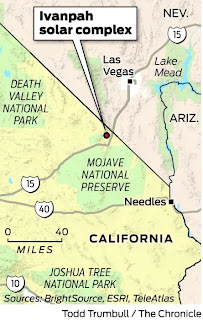David R. Baker
San Francisco Chronicle
BrightSource Energy Inc. of Oakland won $1.37 billion in federal loan guarantees Monday to build solar power plants in the Mojave Desert, becoming the latest Bay Area green-tech company to receive major financial backing from the U.S. government.
The money will help BrightSource build the Ivanpah Solar Electric Generating System, a collection of three solar-thermal power plants that will use mirrors to focus sunlight and generate electricity. Together, the three plants near the Nevada border will produce enough power for 140,000 homes.
The loan guarantees represent two of the Obama administration's key goals: encouraging the growth of renewable energy and creating jobs. Ivanpah's construction will employ an estimated 1,000 union workers. An additional 86 people will run the plants when they become operational.
"This is an investment in American jobs and the clean, renewable energy our economy needs," said U.S. Energy Secretary Steven Chu, whose department awarded BrightSource its funding. "We are not going to sit on the sidelines while other countries capture the jobs of the future."
The Department of Energy's loan program for clean energy projects was created in 2005 but received additional funding through last year's economic stimulus bill. To date, six companies have won loan guarantees, three of them from the Bay Area. Solyndra Inc. received $535 million last year to build its second factory for solar cells, near the company's Fremont headquarters. And Berkeley's Nordic Windpower USA won $16 million to expand its assembly plant in Idaho.
For each company, the funding provides a much-needed boost at a time when conventional financing is hard to find.
"The credit markets, the lending side of all this, is a very challenging environment right now," said BrightSource Chief Executive Officer John Woolard. "Even traditional projects, like a combined-cycle gas plant or a wind project, are really looking hard for financing."
The loans will be provided by the U.S. Treasury's Federal Financing Bank and guaranteed by the Department of Energy. BrightSource won't get them unless the Ivanpah project receives permits from the California Energy Commission and the federal Bureau of Land Management, both of which are reviewing the project.
The bureau already placed Ivanpah and five other large-scale solar projects on a fast-track approval process. But winning approval is not guaranteed.
The Sierra Club and another environmental group, Defenders of Wildlife, have questioned the Ivanpah project's potential impact on the desert tortoise, which inhabits the dry lakebed where the power plants would be built. BrightSource redesigned the project in response, cutting the amount of landed needed. But the Sierra Club still wants one of the three plants relocated to spare more tortoise habitat.
"We're glad the Obama administration is supporting renewable energy," said Barbara Boyle, senior representative for the Sierra Club. "We're just going to continue to work to site these projects in the most environmentally responsible way possible."
BrightSource's plants will use fields of flat, pivoting mirrors to focus sunlight on central towers filled with water. The intense heat generated by the light will boil the water, creating steam that will be used to turn turbines and generate electricity. Power plants using an earlier version of this technology have been producing electricity in the Southern California desert for decades.
In full sunlight, Ivanpah will generate about 400 megawatts of electricity, roughly the same as a mid-size fossil fuel power plant. Pacific Gas and Electric Co. and Southern California Edison have agreed to buy the power. California's utilities face a state mandate to get 20 percent of the electricity they sell from renewable sources by the end of this year, a deadline they are likely to miss.
If Ivanpah wins its state and federal permits, BrightSource may apply for additional federal financing. Last year's stimulus package allows renewable power projects that break ground by the end of 2010 to receive a grant worth 30 percent of the project's cost, in lieu of taking a tax credit of equal value.
